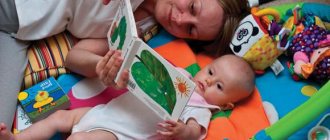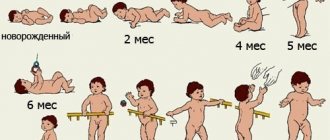When do babies start to roll over?
There is no consensus among experts about when children should start doing rollovers. Each baby has an individual development rate. Norms exist theoretically, but in practice, one baby matures later, another earlier.
But there are still limits of possibility that determine the ability to roll over. Typically, thin children are more physically active than their well-fed peers. Strong babies are able to roll on their side at 2 months. Slow, quiet babies may not be physically active until six months of age.
Some babies at 3 months attempt to roll onto their stomach. This can be done by babies who have learned to hold their head up with emphasis on their shoulders while lying on their stomach. In such babies, the muscles of the neck and shoulder girdle are sufficiently developed.
According to most pediatricians, the norm for the onset of revolutions varies from 2 to 6 months. In most cases, 4-month-old babies are just beginning to roll over.
When does the baby begin to roll over on his own?
Children begin to explore their environment quite early. As soon as their vision begins to adjust and becomes clearer, children try to turn their heads, lift themselves and roll over. If the child himself began to master physical activity in time, then development is proceeding as usual. Very soon the baby will be able to crawl independently and then walk.
That is why for many parents the question of when the child begins to roll over is very acute. Moms and dads worry about whether there are any deviations in the course of development. Basically, babies begin to turn over a little closer to three months. These can be very light movements from side to side, similar to swaying.
In just a few months, the baby will be able to completely turn onto his stomach without any help. Please note that in the first stages it is very important to support the little one’s head, because heaviness may be felt when climbing and turning.
Never leave a one-month-old baby alone on a changing table or any other high surface. Regardless of whether a baby can crawl or not, there is a possibility that he will turn over unsuccessfully, falling from a great height for him.
It is quite difficult to talk about the specific age when a newborn begins to move. Not a single pediatrician can give an exact figure at how many months a child begins to roll over.
This indicator is purely individual, just like the ability to walk or talk.
Children master turning over after they manage to lift their head and turn their neck, but there are a number of factors that determine the ability to turn from side to side:
- newborn weight;
- character traits (calm baby or very active);
- heredity;
- muscle tone;
- the presence or absence of injuries during childbirth and the postpartum period.
So, if the baby is very active, mobile, and he shows interest in everything that surrounds him, then in the absence of injuries he can begin to roll within 2-3 months after birth. Phlegmatic people sometimes master this skill only six months after birth.
The entire period of development of this skill can be divided into separate stages, which depend on the baby’s progress. In the chart provided below, you will see a monthly breakdown of active activity.
3 months
At this age, the child already begins to actively turn his head to the right and left, looking at everything around him. This promotes rapid development of neck muscles. The upper part of the body begins to strengthen.
4 months
There is some confidence in the movements. It is no longer enough for him to simply turn his head; he begins to fall onto his right or left side, trying to turn. Some babies at this age can already roll over onto their stomach with a little help from their parents. They are able to return to their original position on their own.
5 months
The majority of children at this age perform independent rolls onto their stomachs and back.
6 months
At this age, the baby is already obliged to make such movements independently. If this does not happen, and no injuries were identified during childbirth, you need to consult a doctor. This may indicate slow activity of the nervous system.
8 months
The first revolutions at this age can become the norm only if the child was born premature. If even with your help no movements are possible, you should consult a doctor.
Healthy children make their first movements within 3-4 months after birth, and for a toddler with injuries or a diagnosis of prematurity, a period of 6-8 months can become the norm.
First attempts
The first attempts at such movements are awkward. All attempts to roll onto the other side or stomach end in failure. If you can't get your baby interested enough to start moving, try luring him onto his side with a large toy. It is desirable that it be bright and noisy. The main thing is that it can attract attention well and move up and down.
You must also understand that attempts to roll over will fail until the muscle corset gets stronger. This may take weeks or even several months. The main thing is not to give up, because only you can help your baby. After the first success, the little one will repeat the movements he likes.
From belly to back
In order for a newborn to be able to roll over from his stomach to his back, the muscle corset must be sufficiently developed. To do this, parents need to provide him with the right physical activity.
During the day, the child must move actively, otherwise you will get an inert newborn who will begin his first movements and steps only after a year.
We invite you to read: Rules for safe behavior of children in the city
This is why parents must constantly develop the skill of turning over.
During the period of activity and wakefulness, you should put the newborn on his stomach and see how he behaves. If you see that the baby hardly reacts, try to interest him in some thing. After this, observe the reaction.
If the little one tries to roll over, help in every possible way with your hands. If you make such attempts regularly, you will achieve results within a month.
The main thing is not to use the same object to attract attention, because it can get boring very quickly.
From back to stomach
There are special techniques to teach your baby to roll over from his back to his stomach. This is a little more complicated than the previous method. To do this, it is also necessary to strengthen the muscle corset.
Special gymnastic exercises and massages will help. It is very good if parents teach their newborn to swim, because it is in water that the muscles train best.
As for the method itself and attempts, everything is similar to the first method.
You will not be able to achieve results quickly if you only exercise two or three times a week. Constantly supervise your little one, because all children are different: some help themselves to turn over with their hands, others push their body with their legs. Some children cannot understand at all where to put their arms and legs, what to do with them.
If you want to teach your toddler to roll over correctly, and for this to happen as quickly as possible, provide him with the right conditions. Pay attention to your baby's basic skills. If he cannot independently turn his neck or raise his head, then it is unlikely that he will be able to achieve success in his movements.
Work with your newborn in such a way that he learns to hold his head upright. Raise his head, provoke him to turn his nose in one direction or the other. In addition, the baby will not be able to turn his body over correctly if he does not have solid support under his back. Try to place it on a table or floor, which must be warm.
The toddler should also have incentives to roll over. Otherwise, interest will quickly fade. Be sure to use bright and noisy objects. It is advisable that they are familiar to the little one. These could be toys that hung above his crib.
Start working with your newborn only with the right emotional attitude. When both the baby and the parents are in a good mood, the process will go much faster and more successfully. If the newborn is hungry, has restless sleep, and the parents are very tired, there is very little chance of winning in a short time.
Parental help
The help of parents in this case is very important. Without their support, the child will not be able to independently make active movements. First, mom or dad pushes the baby, then he begins to try on his own, as he feels comfortable and familiar.
All techniques are aimed at developing the muscle corset. It is very important to pay attention in time to those muscle groups that are lagging behind in development. If this is noticed in time, you can use exercises to tighten this or that part of the body, which will help you begin physical activity faster.
- Aimed at stimulating specific points on the body. You should place your newborn on his back and gently turn his head with your fingers. To begin, simply raise your head slightly towards yourself. When you see that this movement is easy for the baby, you can turn your head from side to side.
- It involves training to turn on your side. This exercise can be performed as early as three to four months of age. Place your newborn on his side, but do not force him to remain in this position for long. The baby should feel that he is lying naturally and at ease. Hold your baby like this for a few minutes. It is better to immediately remove your hands, and if you notice that he is fidgeting, starting to whine and be capricious, immediately turn the newborn back over.
- Trains control of turns. Place your baby on his side and use your hands to support the hip area and upper shoulder blade. This is the position you should hold it in. Apply a little pressure with your hands on the body, but very lightly (you should push it a little to move). If the little one tries to roll over, then hold the leg a little so that he has to make an effort to turn. In a few weeks he will learn to move independently.
As soon as a baby learns to roll over and crawl, a very traumatic stage of his life begins. Best used for training:
- cozy warm floor, which will be covered with carpet;
- the surface must be clean;
- no sharp objects;
- High tables, chairs or cribs without sides should not be used.
Possible problems
If a baby is unable to roll over on his own, this does not always mean that something has gone wrong in his development. This is influenced by a number of factors.
- The baby may simply not have the incentive.
- Much also depends on the baby’s temperament; if he is quite passive, then he may simply not be interested in turning over.
- Problems may also arise in children who have problems with the development of the muscular corset. If parents do little work on the physical development of the newborn, then his tone can provoke a lack of progress.
In other cases, deviations may be due to:
- delayed general development;
- cerebral palsy, autism and other problems;
- injuries;
- disorders of the nervous system.
What can a 4 month old baby do?
At this age, children have achieved certain successes in physical development. Some babies independently roll over from back to stomach. Most babies master the following physical skills:
- confidently hold their head upright;
- reach out to toys;
- actively move their legs while awake;
- lying on your stomach, make a “bridge” - resting your arms, raise your head and arch your body;
- take the “airplane” pose - lying on your stomach, spread your arms wide and raise your legs.
Children develop meaningful reactions. The approach of a loved one causes joy, which is manifested by active movements. Seeing the stranger, the baby freezes. When communicating with parents, she laughs and recognizes the voices of loved ones.
Why don't babies roll over from their stomach to their back, and what to do about it?
If on average we talk about how many months a baby begins to gradually learn to roll over, then this happens at the age of 3-4 months.
But with turning in the opposite direction, the situation is a little more complicated, so parents can note the emergence of such a skill in the baby, starting from 4-5 months of age. With the help of mom or dad, the baby can master this process much earlier. But parents must be sure that the baby is ready for this. This can be assessed according to the following criteria:
- the baby responds to sounds by turning its head while lying down;
- the baby raises his head while lying on his stomach (parents call this action the gentle term “herding horses”), sometimes leans on his elbows;
- the baby can lift and hold his head for about 5-10 seconds while lying down;
- the child gradually examines his face, head with his hands and pushes off with his legs from the palms of his parents.
The character and temperament of the child plays an important role.
It's no secret that nimble, curious children begin to walk, talk, and run much faster. The same goes for turning over. For them, this process is very exciting and entertaining, which is why they learn faster.
Phlegmatic babies master the technique of turning more slowly, gradually. They are wary of this process, may become indignant, and sometimes even start crying. In this case, parents should be patient so as not to scare the baby.
On a note!
Don't forget about the hereditary factor. If one of the parents began to roll over, walk and talk late, then the same phenomenon may appear in the child. This is not a deviation, so you shouldn’t draw premature conclusions or, even worse, “diagnose” your baby yourself.
Not all children manage to learn such a complex process as turning over. Even with constant training with parents, it is not always possible to achieve the expected results. There are reasons for this that you need to know:
- Violation of muscle tone. Hyper- or hypotonicity – it doesn’t matter. Both conditions are equally dangerous and require mandatory medical intervention. The fact is that these are not independent diseases, but symptoms of rather serious conditions. Of course, increased skeletal muscle tone in many children persists until approximately 3-4 months. It is during this period that the baby learns to roll over, so difficulties with this can be attributed to this – temporary – deviation.
Child's muscle tone - Trauma during childbirth. If, while moving through the birth canal, the child injured his head, then in the future this may cause a lag not only in mental, but also physical development.
- Prematurity. Premature birth also affects the baby's reflexes. It takes longer to train such children, so don’t panic right away.
- Large body weight. Children born with large, excess weight develop slightly slower than those born with optimal body weight. But there is an explanation for this. They do not roll over not because of a delay in physical development, as such, but only because the extra pounds prevent them from doing it as they should.
With such babies, parents must work longer, more persistently. - Temperament type. As already noted, the type of character and temperament has a direct impact on the child’s learning ability. And turning over on your back or tummy is no exception. Phlegmatic people are more indifferent to this process. Choleric people can start crying and screaming for no reason if they become uninterested. Therefore, it is important to consider the child’s psychological readiness and mood before starting classes.
Important!
If a 3-4 month old child has not yet begun to attempt to roll over onto his side or back, you should not force things. First of all, you need to observe him and try to do different exercises. And only if they turn out to be ineffective, you need to seek help from a specialist.
Physical development of a 5-month-old baby
By this time, the child is able to overcome body weight. Leaning on his outstretched arms, he sways, pushing off with his legs. Lying on your back, raises your head and shoulders. These movements indicate a rapid desire to get up.
If you support the child under the armpits, he stands steadily on his legs for 2–3 minutes. Some babies independently master turning over from back to stomach and back.
If a 5-month-old baby does not roll over, do not worry ahead of time; each baby has its own pace of physical activity. Most children will only need to increase their practice time.
Possible reasons for the 5 month delay in coups
Most often, if the baby does not roll over at 5 months, there is no cause for concern. But in some cases, pathological factors that require specialist consultation contribute to developmental delay.
Among the main reasons for the lack of coups are:
- Lack or excess body weight;
- Injuries (including birth injuries);
- Muscle tone disorders (hypo-, hypertonicity, dystonia);
- Pathology of the nervous system (perinatal brain damage of various origins);
- Diseases of the osteoarticular system (hip dysplasia, congenital hip dislocation).
If the baby was born large (more than 4 kg), then learning new skills will be difficult due to excess weight. These babies have reduced innate reflexes such as automatic walking and crawling, they are obese and clumsy.
A baby who was diagnosed with intrauterine growth retardation at birth and has a low birth weight also cannot master motor and other skills in a timely manner. This is due to the fact that the baby’s body is weakened and often the low weight is accompanied by a pathology of the nervous system.
Trauma to the cervical spine, intracranial traumatic brain injuries received during childbirth or in the subsequent period (fall, shaken baby syndrome) lead to damage to the nerve cells involved in conducting impulses and promoting motor activity.
Impaired muscle tone occurs when any part of the nervous system is damaged, which can be caused by various reasons, including congenital anomalies. Due to a violation of the coordinated work of muscles, it is difficult for the baby to perform one or another movement.
Perinatal damage to the nervous system can occur as a result of:
- injuries;
- oxygen starvation;
- infections;
- toxic effects;
- metabolic disorders that affect the fetus in utero.
As a result, the parts of the nervous system responsible for motor functions are damaged.
Pathology of the hip joint prevents the baby from making active movements due to limited mobility in this area.
If the baby is closer to 6 months and does not attempt to roll over, then you should consult a doctor. After establishing the cause, the doctor will prescribe medication and physical therapy, prescribe a course of restorative massage and select the necessary complex of physical therapy.
How to help a 5 month old baby acquire a new skill?
If there are no serious reasons why the baby is not yet turning over, then you can independently prepare the child for turning over. Before learning a new skill, take safety precautions:
- Under no circumstances should a child be left unattended on a changing table, bed without sides, or sofa;
- There should be no piercing, sharp or small objects within the baby’s reach;
- The place where the baby sleeps should not be soft; pillows and soft toys (objects in which he can bury himself) should not be left nearby;
- The sleeping blanket should not be bulky and heavy; it is better to wear warm pajamas at night (if the apartment is cold) and, if necessary, cover the baby with a diaper or a thin blanket;
- If you need to leave the baby for a short time, then he needs to be placed in a playpen, crib or on the floor covered with a special rug or blanket.
If a 5-month-old baby does not roll over onto his back and/or tummy, the following exercises may help:
- Placement on the tummy several times a day (5 – 10 minutes before feeding);
- Place the baby on a flat surface with his back. Place the thumb of your right hand in his right palm, and clasp the rest of his wrist. With your left hand, use a “fork” to grasp the legs in the area of the ankle joints. Rotate the child's pelvis with straightened legs to the right. The upper part of the body will tighten itself, and the baby will roll over onto his tummy. Repeat for each side 3 times;
- Place the baby on his right side and let him lie there for a while (1-2 minutes). Pull the left handle slightly to the side and up. The baby will roll over after her. Repeat 3 times for each side;
- To roll over from tummy to back, carefully pull the baby's arm along the head and push him in the pelvic area on the opposite side. Repeat 2 times on each side.
In addition, it is useful to exercise with your baby on a fitball, performing rocking and springing exercises on the tummy. If possible, organize swimming lessons for your child in the pool. Being in the water is very useful, because... it:
- strengthens all muscle groups;
- develops the respiratory and cardiac systems;
- promotes neuropsychic development;
- hardens.
Any activity with the baby is carried out in a warm, well-lit and comfortable place in the interval between feedings. The emotions of mother and child should be only positive. If the child screams or cries, then it is better to postpone the lesson for a while.
It is always worth remembering that each child is individual. Everyone has their own pace of development. Some people master new skills ahead of the curve, while others lag behind. Don't worry and compare your baby with the neighbors' children. If in doubt, you need to contact a neurologist and pediatrician. Doctors will determine the cause of the delay and give recommendations on the necessary correction methods.
Valentina Ignasheva, pediatrician, especially for Mirmam.pro
Causes for concern
Infants develop according to individual programs. Parents should be concerned if their baby is falling behind in three or more of the following:
- does not hold his head confidently;
- minimal motor activity of the limbs;
- there is no babbling;
- the baby is not interested in toys;
- does not smile when communicating with loved ones;
- does not show a joyful reaction to the appearance of his parents.
Deviations on 3 points indicate developmental problems. In this case, the baby needs specialist advice. The pediatrician will conduct the necessary tests. Some children will need to be examined by a neurologist or endocrinologist.
Parental help
Do you have a 5 month old baby? Development of what a baby should be able to do - the issues discussed above. Now let's talk about how you can help your baby master this motor skill. First of all, you need to listen to the following recommendations:
- A flat surface is required for training. You should not constantly carry a child in your arms, because muscle training is an independent physical activity. Leave the baby to just lie on the bed for 5-7 minutes.
- Professional massage, which should only be performed by a specialist.
- An auxiliary warm-up that can be done when changing diapers (flexion and extension of the legs).
- Exercises. It is useful to use an inflatable large ball for gymnastics, on which the child lays out. The ball with the child lying on his stomach can be slightly rotated to the sides.
- Simulated swimming. During bathing, it is advisable to allow the child to move his arms and legs freely.
Reasons for the lag
As for congenital diseases, due to which children do not roll over, they are recognized by specialists in the maternity hospital. If the baby does not have the pathology recorded in the card, there is no need to worry unnecessarily.
Below are the reasons why a toddler may not roll over at 4 months.
- An overweight child is slow to master physical skills. If your 4 month old baby weighs 6kg, don't be surprised if he doesn't want to roll over.
- Hereditary predisposition indicates an underdeveloped neuromuscular system. Such children need free swaddling, periodic massage, and gymnastics. Strengthening the muscles at 3 months of age will help to roll over.
- Different temperaments - calm, slow babies are physically inactive.
- Features of development. Some children do not roll over from their back to their stomach, but immediately learn to crawl and sit.
- A premature baby is developmentally delayed, but this is not considered a pathology. After all, the baby’s organs have not yet matured compared to their peers.
- Rickets is characterized by a lack of calcium in the body. Such children sweat a lot and suffer from poor appetite. Their large fontanel is slowly overgrown. Weak muscle and skeletal systems negatively affect physical activity.
- Iron deficiency anemia leads to developmental delays. The disease occurs in a latent form. Anemia can be recognized by pale skin, tearfulness, and poor weight gain.
If a child does not roll over at 4–5 months, this does not indicate health problems. It is important to monitor your skills and abilities. Notice whether the baby responds to sounds. Does he turn his head in their direction? Does your eyes search for the source of the music? What matters is whether the baby, lying on his back, can raise and hold his head vertically.
How to teach to roll over
A 4 month old baby does not roll over onto his stomach
In the third or fourth month of life, the baby should begin to learn to roll over on its own. Parents have the power to help their child so that learning goes faster and more successfully.
Massage and gymnastics
For an adult, the best way to strengthen his muscles is through strength sports. They are not yet available to the baby. Their role for now is performed by massage. He can be professional and superficial. The first should be carried out only by a specially trained children's massage therapist, the second - by parents.
Massaging should include rubbing the limbs, pinching (including the tummy), and patting. It is imperative to control the strength of your hands: the movements should be effective enough for the baby, but not painful. Excessively strong pressure can injure the baby.
Pinching the abdomen and sides will be especially useful in mastering coups. This simple exercise improves blood circulation in the desired area, warms up the muscles and encourages the baby to tense them. Finally, it improves the baby’s mood if done correctly (without discomfort).
Massage usually precedes gymnastics. During it, the child’s body is not only exposed to external influences, it is also stimulated to move more. For example, the following exercises are very useful:
- Pull-ups. The baby is placed on his back. The adult places his thumbs in his palms, the baby must grab them. The parent insures the child's palm with his own. You need to slightly lift the baby by the arms, holding them at the level of his face. Not in a sitting position - this will harm the spine. So that the children's shoulders come off the surface. The purpose of the exercise is to force the baby to tense his tummy and arms, to stimulate attempts to pull himself up.
Baby pulls himself up
- Revolutions. After the warming massage, you need to take the baby by the right thigh and turn him to the left. The left leg is simultaneously held in place. The baby will begin to roll over and his shoulders will follow his pelvis too. So the adult will show the baby exactly what he needs to do.
Swimming
It is better if the little one does infant swimming in the pool. This physical activity makes all the muscles of the body tense, which strengthens them, but also relaxes them, so you can go swimming at night. If a child does not roll over at three months and does not even try, his muscular frame definitely needs such strengthening. Swimming on your stomach will be extremely beneficial.
It is important to note! The use of a circle in this case is not necessary - it supports the neck itself, provoking muscle relaxation rather than tension. It is better for healthy swimming to hold the baby in the water in your arms. This will force the baby to try to control the position of his body.
Laying on the stomach
The sooner and more often you put the baby on his stomach, the sooner he will try to roll over on his own. This simple action will strengthen the muscles of the tummy and neck, and awaken interest in the world around you. It is recommended to lay it out on a hard and flat surface - on the floor, for example. You can practice exercises on a fitball: springs, rolling the ball when the baby lies on it on his stomach.
Baby on fitball
Note! It is important not to overdo it with training.
If you are too active with your child, he may begin to be afraid to do what is expected of him.
How to help your baby learn to roll over?
To speed up your baby's turns, you need to work with him more often, starting from 3 months of age. Pediatricians recommend stimulating a child’s physical development in the following ways.
- Place your baby on his tummy more often. In this position, he will try to raise and hold his head, strengthening the neck muscles. To keep your baby in this position longer, place a bright toy in front of him.
- Water procedures are useful to strengthen the abdominal muscles. Before going to bed, let your baby splash around in the bath to his heart's content.
- Do gymnastics, alternately bend and straighten your limbs.
Regular exercises train the child’s muscles and stimulate physical activity. You should exercise with your baby 2 times a day, an hour after feeding. You should not play educational games when the baby is in a bad mood or is capricious.
How and at what age should a child be helped?
Parents play an important role in the development of a child. Of great importance is the fact whether the mother does gymnastics with the baby or gives him a massage. All these physical exercises help strengthen muscles. To help your baby learn to roll over, you need to perform certain actions from about four months onwards.
- Start with the simplest things.
The child lies on his back. Take a bright toy that interests him and show him from a distance. As soon as the baby tries to reach it, put it aside. The baby will want to get the object and turn over on its side. Push him a little, usually enough to end up on his stomach. In this position, one of the toddler’s arms may be under him. Don’t help get it out right away, let the baby try to do it on his own. To encourage your baby to roll over onto his stomach, get him interested in a toy. - The starting position is the same - the baby lies on his back.
Take him by one leg and gently move it behind the other so that the baby begins to roll over. You can give the little one your finger, he will grab it and easily roll onto his stomach. To help your baby roll over onto his stomach, help him by placing one leg behind the other. - Take the child by the right hand and right leg.
Very carefully (do not pull the baby) start turning him over. This exercise is great for showing your baby how to be on his or her tummy. Regular exercise will help your baby learn to roll over faster. - The baby is on his back again. Take him by one hand, let him grab your finger and try to pull himself up. Place your other hand under the child’s heels as a kind of support. The baby will push off with his legs, this will make it easier for him to turn over.
Do not forget that all exercises must be performed in both directions. Even if the child has learned to roll over on his right side, do not stop training until he can independently roll over his left.
Don't assume that your child won't be able to understand what you're trying to teach. Children are very smart; they quickly grasp what adults want from them.
Our girl at 2 months. During the examination, when checking the tone of the legs, the neurologist sat her down, and then put her on her legs - in the evening my daughter would throw a concert if she wasn’t seated. At 3 months the same neurologist showed how to teach him to roll over onto his tummy, by the evening the child had already tried, and in the morning with difficulty, but she turned over... I don’t know, or it’s just the time has come, or really what worked in the head, but all our achievements were after showing exactly how this must be done.
Yulia_K
https://www.komarovskiy.net/forum/viewtopic.php?t=2692&start=45
Neurologists and pediatricians explain that in addition to special exercises, daily physical activity is necessary to help the child quickly master turning over, and a little later - crawling and walking. Of great importance are:
- swimming, which perfectly trains muscles, strengthens the baby, and also strengthens his immune system. Not all parents have the opportunity and free time to go to the pool with their baby, but you can swim at home in the bathtub, filling it with warm water at 37 degrees and immersing the baby in it. It is advisable to carry out such exercises in the evening;
- exercises on a fitball - a large ball, which is considered a wonderful exercise machine for a baby. They are fun, exciting and very useful, especially for the muscles of the back and neck. Children, as a rule, really enjoy such exercises;
- daily massage. If the baby has no problems, the mother can massage herself at least twice a day, and preferably more often;
- walks in the fresh air, which is important for the normal development of the baby. Doctors recommend walking with your baby at least twice a day for one and a half to two hours.
Exercises for turning from back to stomach - video
How to work with a child correctly
Often during classes the child is capricious and does not want to do the exercises because he did not get enough sleep or something is bothering him. For training to be beneficial, it needs to be organized correctly :
- never deal with the baby immediately after feeding, but only after forty minutes;
- prepare the surface: it must be elastic and necessarily smooth;
- Before classes, ventilate the room: fresh and cool air is ideal conditions for a child;
- choose comfortable clothes that will not squeeze the baby’s skin, or even better, completely undress the baby. Air baths are very beneficial for a baby, and it is much more convenient to perform tasks when nothing restricts movements;
- listen to your little one: if he cries or is capricious, it is better to postpone the exercises or reschedule them for another day;
- stimulate the baby: place a new brightly colored toy in front of him so that he reaches for it.
This will help you master the flip skill faster. A bright toy will motivate your baby to roll over










